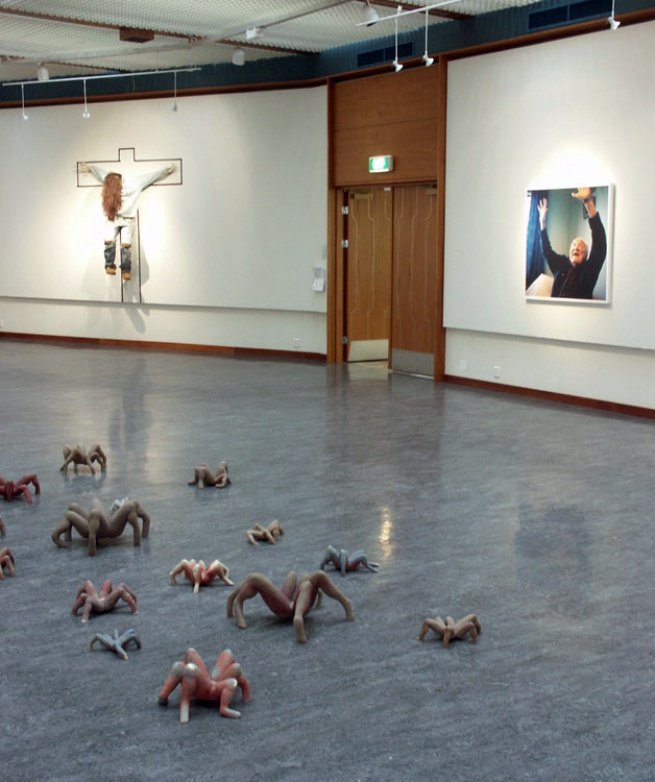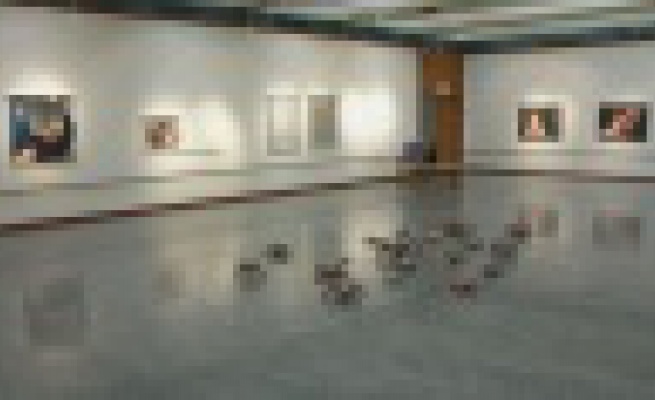Vestland's Exhibition 2007

Today's political and cultural climate is actualized in our relation to faith, norms and life styles. Traditional faith confronts secular society, while new religious forces, new moral codes and alternative life styles are also current. All this makes for new stories about our lives. Good and evil, love and hate, fear and safety are contrasts, held in tension between the restrictions we set for the acceptable and unacceptable. Between the bi-polar extremes, fervently held attitudes of life are set in motion, and a strong duality arises where zealous believers congregate. What, then, does it entail, to give oneself to a cause, a belief-system or an agenda? How do attitudes and convictions come to expression? How do people organize themselves religiously? Conviction, devotion, control, power and chaos – these are some of the questions that provide the genesis for this exhibition.
The elite, the chosen – those who have the right faith, politically or religiously, who possess unique energies, the enlightened, the brotherhood, the subculture, the holy community of believers. There are those to live in the right geographical location, and what of having the right network? What of art as a form of religious practice? I do not think of artists as having received a God-given call, but faith is nevertheless an interesting concept in art, or perhaps better said, a loss of faith. Faith, doubt, loss, faith doubt loss – in an unending cycle. The artistic milieu one belongs to can function as a little religious community, where one runs about championing truths and then tearing them down, in a steady stream, almost like clock-work. And the gallery, the arena, places where the faith is practiced, with sacrifices, blood and gore. But enough of this!
May 18, 2006. I read in the news that a hunger-striking Pakistani has ended his protest today; for some weeks he has laid in a tent in front of Oslo Plaza. The man has been offered a meeting with the airline he is protesting against, since they raised their ticket prices to Pakistan. Everything is back to normal. I cannot help smiling over the tremendous range of things people get involved in.
Vestland's Exhibition 2007 wants to examine faith in a wide sense. People in groups, as a flock, a congregation, marching in step or going it alone. New political orientations or sub-cultural self-organizations arise in relation to moralism and religious fundamentalism – undermeagre conditions. When Christian Fundamentalism grows we are tempted, particularly we who have a sober Protestant history. Demonstrations of power make us nervous, but we are like dogs panting after new rituals.
Vestland's Exhibition 2007 presents 21 works, and almost all the participants are debutants. The artists represent a plurality of artistic expressions; there are idea-based works that operate in a conceptual direction, works that appeal to the viewer's power of imagination, and there are staged events. Signe Christine Urdal's photograph Alf is part of a larger documentation project of photographing people who live in a nursing home. More than the everyday comes to view in the photo of one of the inhabitants, who, with his gaze turned upwards, stretches his hands in the air. Sverre Malling is represented by several charcoal drawings. The landscapes include details from ground level, e.g., pills, forgotten things that cause one to think of remains from a party. Lying helter-skelter, the left-behind objects bear witness to something that once took place, while nature and its creeping things continued to exist on the side. When the party was over, nature took over the space. The exhibition's guest artist, English Lindsay Seers, is a video and performance artist with a unique artistic universe. With stories and approaches to problems of perception that repeatedly stage her own life, Seers' videos cause one to think of 'being different' as a particularly potent quality. In her attempt to capture the datum point of staging, she has insisted on depicting the world, has experimented with becoming a camera, and has eventually taken on the role of a projector. Her latest video, The Truth Was Always There, concerns a personal narrative played against a historical and academic one. The video's meta-narrative, about its ability to influence the viewer, is that type of faith one can examine through photography and film. Karl Ingar Røys harnesses the potential of documentary in order to make a serious proposal. Erna's Video presents a media-critical story about the use of power, and how Norway's former Minister of Local Government and Regional Development collaborated with the mass-media in order to control immigration from the Balkans. Hans Sande's enlarged photographs are a type of self-portrait in which the artist himself is absent. The imprint of his body appears as a monstrous or monumental figure in the snow. The body's vulnerability becomes apparent when one thinks about the warm man who has lain there.
The Believers – We are the Chosen Ones! Vestland's Exhibition 2007 invites visitor participation and wants to create contact with the cities and places where the exhibition takes place, and to focus on the specific locations. Towards these ends we also present site-specific works and performances that actively stand in relation to the places and situations. Ann Kristin Bergersen's performance Cut Out challenges the public's power of imagination. Here short fragments of movement appropriated from Film Noir thriller-scenes and detective films are put together. The action fragments and sound bites are woven into each other. Bergersen herself plays the various character roles in the performance that takes place in the spaces between the other works on the exhibition floor, and a single spotlight provides the framework for the scenes. The actions are repeated in a loop, like a broken record, like ritual patterns the body develops in order to regain control. Hjørdis Kurås' sound installation will only be experienced in the public space. The victory song of the football team Vålerenga, played from a trophy, is a humoristic creed as well as an enthusiastic testimony in a wider sense. If we know that 'Vålerenga' is a concept used in marketing an Oslo suburb, and is also actively employed as a product label for real-estate entrepreneurs, football and youth work, it gains greater significance than football supporters' "worship" of their own team.
A friend of mine loans her neighbour's car. The car keys hang in a ring with a little transparent plastic bobble containing a text: "Jesus is the way". My friend relates that the car was inherited from a grandmother, who laid the condition that whoever drove it should never take the key-ring off as long as they used the car.
There are varying opinions about the justification and organization of regional exhibitions in relation to regional affiliation, and a system where everyone is invited to apply for participation. Vestland's Exhibition has chosen a middle road, entailing, on the one hand, an artistic leader and a thematic exhibition, but on the other, an open invitation with the stipulation of regional affiliation. In this way we have created a focused exhibition, one can present the region's culture simultaneously as all applications for participation are taken into consideration. Vestland's Exhibition 2007 is an appealing arena for young artists. This year it has experienced a considerable increase in applications in relation to recent years. In a group exhibition such as this, the curation and general theme must not reduce the works, but provide room for several interpretations. Meanwhile, without being thematically directed or controlled, the exhibition is an anthropological study of Western Norway, and this limits and sharpens the scope for participants and public alike – for it is less bracing to create an exhibition only in relation to regionality. Vestland's Exhibition is undergoing a process of change and wants to take into account contemporary artistic expressions. Video, performance and site-specific works require more planning, follow-up, equipment and production costs than conventional artworks. Vestland's Exhibition has, as far as I understand, traditionally had a form of exhibition and an approach based on two-dimensional artworks. Moreover, much of the preparatory work was founded on idealism. It is, however, important that an exhibition such as this be able to pay reasonable honorarium in order to help set a justifiable standard. More priority must be given to the exhibition in order for it to function optimally. It should not be impossible to improve the conditions for an important exhibition.
Artists:
Agnes K. Johnsen, Ann Kristin Bergesen, Hans Sande, Hjørdis Kurås, Jan Steffensen, Jannicke Kristoffersen, Karima Risk, Karl Ingar Røys, Kjersti Sletteland, Kjetil Kausland, Kristian Øverland Dahl, Kristin Lian Berg, Lindsay Seers, Magny Tjelta Jaatun, Sex Tags, Sidsel Christensen, Signe Christine Urdal, Sturla B Grøvlen, Sverre Malling, The Hungry
Hearts, Ulf T Kristiansen.
